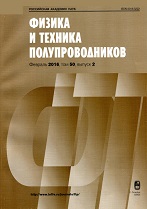|
This article is cited in 3 scientific papers (total in 3 papers)
Semiconductor physics
Comparative analysis of the optical and physical properties of inas and InAs, In$_{0.8}$Ga$_{0.2}$As quantum dots and solar cells based on them
R. A. Saliia, S. A. Mintairova, A. M. Nadtochiyab, V. N. Nevedomskiya, M. Z. Shvartsa, N. A. Kalyuzhnyya
a Ioffe Institute, St. Petersburg
b Alferov Federal State Budgetary Institution of Higher Education and Science Saint Petersburg National Research Academic University of the Russian Academy of Sciences, St. Petersburg
Abstract:
InAs and InAs, In$_{0.8}$Ga$_{0.2}$As quantum dots in a GaAs matrix as well as GaAs solar cells with quantum dots of both types in the
$i$-region are obtained by metalorganic vapor-phase epitaxy. As a result of investigations by photoluminescence and transmission electron microscopy, it is found that the InAs, In$_{0.8}$Ga$_{0.2}$As quantum-dot array is highly uniform, contains a smaller number of large imperfect quantum dots, and also provides a decrease in mechanical stresses in the structure. An analysis of the spectral dependences of the internal quantum yield shows that the quality of a solar-cell matrix after embedding up to 20 rows of InAs, In$_{0.8}$Ga$_{0.2}$As quantum dots remains at a level close to the reference GaAs solar cells. In this case, a linear increase in the additional photocurrent generated due to the absorption of sub-bandgap photons in InAs, In$_{0.8}$Ga$_{0.2}$As quantum dots is provided with an increase in the number of rows of quantum dots, since the value of the photocurrent gain per row is preserved.
Keywords:
photocurrent, quantum dots, solar cells.
Received: 20.04.2020
Revised: 12.05.2020
Accepted: 20.05.2020
Citation:
R. A. Salii, S. A. Mintairov, A. M. Nadtochiy, V. N. Nevedomskiy, M. Z. Shvarts, N. A. Kalyuzhnyy, “Comparative analysis of the optical and physical properties of inas and InAs, In$_{0.8}$Ga$_{0.2}$As quantum dots and solar cells based on them”, Fizika i Tekhnika Poluprovodnikov, 54:10 (2020), 1079–1087; Semiconductors, 54:10 (2020), 1267–1275
Linking options:
https://www.mathnet.ru/eng/phts5141 https://www.mathnet.ru/eng/phts/v54/i10/p1079
|


| Statistics & downloads: |
| Abstract page: | 49 | | Full-text PDF : | 20 |
|





 Contact us:
Contact us: Terms of Use
Terms of Use
 Registration to the website
Registration to the website Logotypes
Logotypes








 Citation in format
Citation in format 
